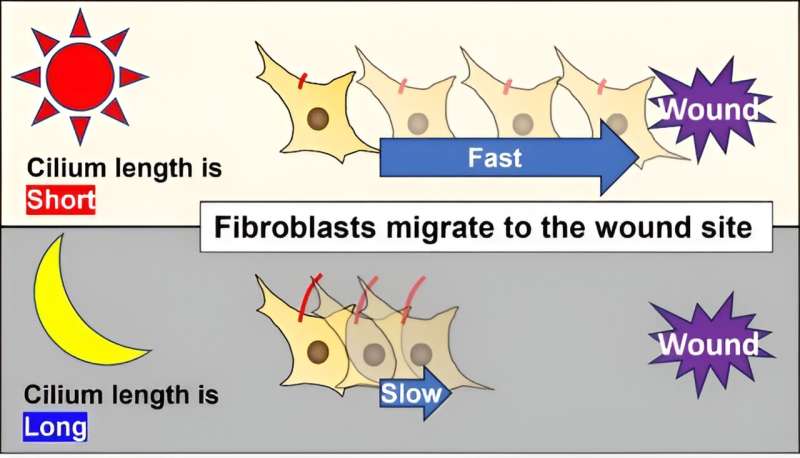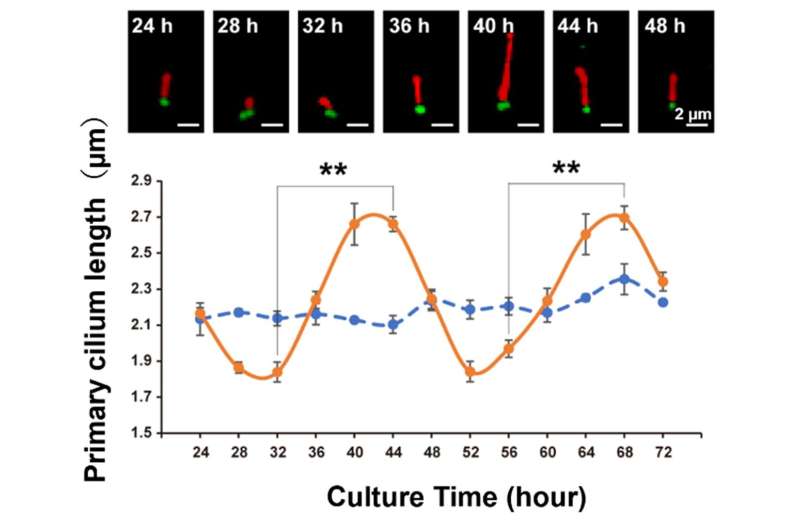This article has been reviewed according to Science X's editorial process and policies. Editors have highlighted the following attributes while ensuring the content's credibility:
fact-checked
peer-reviewed publication
trusted source
proofread
Examining the relationship between the rate of wound healing, the circadian rhythm and cilium length

Nearly every organism on Earth follows a natural circadian rhythm that is coded by your cell's clock genes, which do exactly as you suspect from the name: regulate your body's rhythm on a 24-hour basis.
We're all familiar with our body's internal clock: it gives us cues on when to wake and when to rest, but it also can determine the rate and time of day at which your body most effectively heals wounds.
Most cells in mammalian bodies have cilia of some sort, which are hair-like structures that perform a variety of functions such as movement for motile cilia and aiding in structure in function for non-motile, or primary, cilia. The primary cilia also act as a sensory organ for the cell, a function that has illuminated the primary cilia's potential role in the healing process and how bodies heal at a different rate according to our circadian rhythm. In this research, the role of the primary cilia, biological clock and wound healing is explored.
Researchers have published the results of a study in EMBO Reports.
The main findings concluded that clock proteins, which are proteins that regulate a 24-hour rhythm within a cell and are coded by clock genes, have much to do with the regulation of the primary cilia. The primary cilia act in accordance with the oscillations of the clock gene's expression and can shorten or lengthen throughout the day. The length of the primary cilia can vary and is tied to the healing process of a wound. The shorter the length of the cilia, the shorter the wound-healing time appears to be.
The research done in this study observes cells from mice over 72 hours and the rise and fall of the length of the cilia is observed to be in line with the rhythm of a 24-hour cyclical period.
"This suggests that the 24-hour cycle of primary cilia on fibroblasts may underlie in part the difference of wound healing speed between daytime and nighttime," said Ryota Nakazato, researcher and author of the study. Fibroblasts are cells that contribute to forming connective tissue and are a major part of the healing process. The circadian rhythm in the primary cilia of these fibroblasts is more involved in wound healing during the day than at night.
![Immunostaining image. Credit: Ryota Nakazato, Hiroshima University] New study examines the relationship between the rate of wound healing, the circadian rhythm, and 'hair' on cells](https://scx1.b-cdn.net/csz/news/800a/2023/new-study-examines-the-1.jpg)
The reason for this daytime-induced enhanced healing process appears to be from the relationship the 24-hour cycle has on the length of the primary cilium. During the day, the cilia are shorter and are more easily able to convert to a cell type that can invade the wound to begin the healing process.
Primary cilia are possibly also involved in receiving and sending signals to the rest of the body which can also enhance wound repair. The cells with shorter primary cilia are more easily released from their "anchor" to start cellular migration to the wound site at an earlier time and might also more readily send out signals to increase the rate of wound repair than when the cilia length is longer.
"We expect that further analysis will clarify the role of primary cilia not only in wound healing, but also in various life phenomena that exhibit circadian rhythms, such as sleep/wakefulness, hormone secretion, and changes in body temperature," Nakazato said.

Although there has been some headway made with the connection of these two seemingly unrelated subjects, there's more work to be done to elucidate the mechanism by which circadian rhythm affects the body's physiology, especially in immature or embryonic cells.
These observations allow researchers to further explore the role the biological clock and its disturbances have in various health issues or disorders and can lead to the development of a field of study known as "circadian medicine." The findings from more in-depth research on the physiology of circadian rhythm can aid those who struggle with jet lag, insomnia and other disorders or diseases that may stem from issues in regulating the body's natural clock.
Ryota Nakazato, Faryal Ijaz and Koji Ikegami of the Department of Anatomy and Developmental Biology, Graduate School of Biomedical and Health Sciences at Hiroshima University with Koji Ikegami also from the Precursory Research for Embryonic Science and Technology and Yuki Matsuda of the Hiroshima University School of Medicine contributed to this research.
More information: Ryota Nakazato et al, Circadian oscillation in primary cilium length by clock genes regulates fibroblast cell migration, EMBO reports (2023). DOI: 10.15252/embr.202356870
Journal information: EMBO Reports
Provided by Hiroshima University





















